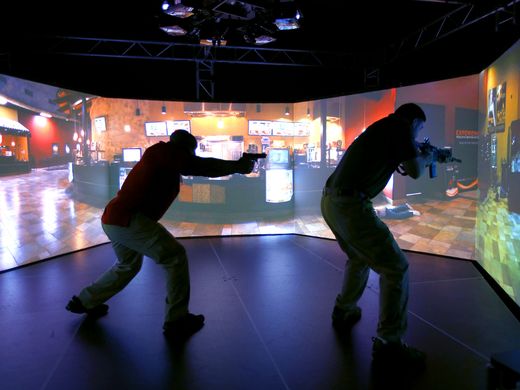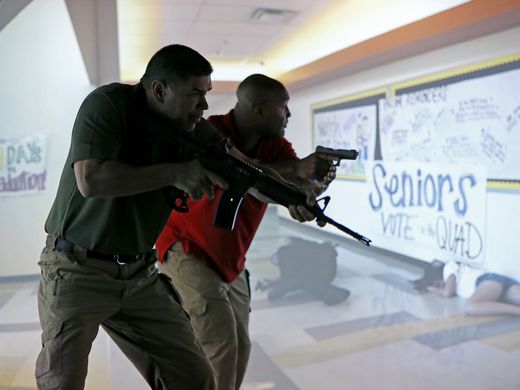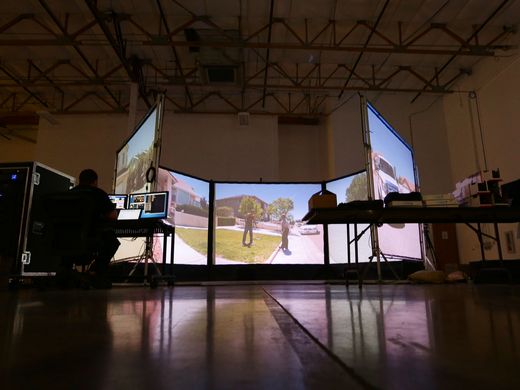
My moment as a police officer got really bad, really fast.
My partner and I had come to remove an elderly man in a wheelchair from his neighbor’s home. The man pulled a gun, shot my partner, shot me and shot the homeowner before I could react. By the time I fired a fatal shot at the suspect, he had dropped his gun and raised his hands to surrender, which was somewhat difficult to explain in my debriefing.
Thankfully this was just a simulation of what real police officers encounter, provided by Tempe-based VirTra Inc., a technology company that increasingly is responsible for how police and military personnel around the world are trained in the use of force.
Training to help officers decide when — and when not — to shoot is especially important in light of a rash of police shootings across the country that have focused public attention on appropriate use of force.
VirTra creates simulators using small theaters encircling the trainee with screens. Actors are employed to play out a variety of on-screen scenarios. The weapons are real, but rather than ammunition, they are loaded with a realistic kickback device. When the user “shoots” a suspect, the suspect collapses in a pool of blood. If the trainee misses, the suspect shoots back.
Oh yeah, the trainees can be “shot” in these simulators.
VirTra makes a stun gun-like device called Threat-Fire that clips to the user’s belt. It has various settings on the size of jolt it delivers to simulate some of the stress associated with the threat of being shot or stabbed. The device can deliver 80,000 volts for 0.2 to 2.5 seconds. My palms began sweating as soon as I clipped it on.
“What we are trying to do is simulate a fear response and some pain and some stress,” said Scott DiIullo, who handles federal law-enforcement business development for VirTra.
“It is remarkable for some departments to see how their officers respond to this,” DiIullo said while demonstrating the electric pulse.
Different scenarios for different clients
The 60 employees at VirTra have developed simulators used by law-enforcement officers across the country, including U.S. Customs and Border Protection, the Secret Service and the U.S. Department of State. The simulators are used in 19 countries, including Australia.
VirTra has a variety of scenarios that can be used for training, from traffic stops to hostage situations in war zones. Customers can request custom content and, using VirTra’s platform, can create their own so it can train people on specific scenarios or particularly troublesome locations in a city.
The company aims to help law-enforcement officers make better decisions when deciding when to use force and to diffuse situations if possible. In addition to firearms, the simulators can provide practice with non-lethal weapons like Tasers and rifles that shoot bean bags.
DiIullo said most of the time when police use their weapons, they are justified.

Border Patrol agents take part in training on the VirTra police-shooting simulator at company’s headquarters in Tempe on Wednesday, Sept. 17, 2014. The simulator uses commands to de-escalate scenarios to prevent fatal shootings when possible.
“The issue is, how did they get there?” he said. “That is tactically where we need better training. We expect them to make these critical use-of-force decisions, and they are not getting the training. In high-stress situations, sometimes they don’t make the right decision or they make a late decision.”
VirTra simulators allow trainers to evaluate how well officers use verbal commands and attempt to de-escalate a situation. The person operating the simulator can prompt different outcomes where the actors on screen either surrender, run or attack.
“It is never going to take the place of a real-life event, but the closer we can get to it the better,” DiIullo said. “A more confident officer is going to de-escalate a situation better than an untrained or unconfident officer.”
The simulators also prevent what VirTra officials call “training scars,” where officers practice standing still and shooting at moving targets.
“We have to untrain them,” he said.
In a real gun battle, officers need to seek cover while they return fire, and the simulators give them the opportunity to evaluate their surroundings to look for cover, not just what is downrange.
The company also takes pride in hiring actors to lend realism and emotion to the scenarios.

Border Patrol agents use the VirTra police-shooting simulator at the company’s Tempe headquarters on Wednesday, Sept. 17, 2014. The V300 simulator uses five large projection screens to create a 300-degree training experience.
“All the old simulators, the actors were cops,” DiIullo said. “It breaks the reality. They can’t act.”
He mimicked a police officer acting, poorly, as though he had been shot.
After a simulation is run, the trainees can review the video, which records when they fired their weapons, what was visible on the suspects at the time, and what the officers said leading up to the shooting. VirTra officials make trainees write a post-event report when they run the training, DiIullo said.
Many of the employees at VirTra are former police or military, including DiIullo, who spent 20 years with the Scottsdale Police Department. The company also hires subject-matter experts who have either been in live-fire situations in law enforcement or in war zones, and uses their input to develop simulations.
VirTra also sends its experts to the Force Science Institute, a Mankato, Minn., organization that researches deadly police encounters.
The nuts and bolts
VirTra’s high-end simulators can cost $200,000 to $300,000 depending on the features included. The company makes various models, but the most expensive unit uses five screens to create a 300-degree field of view and surround sound to mimic voices or noises from different directions.
Most of the company’s products are fabricated in the 40,000-square-foot office space on Kyrene Road in Tempe, though VirTra also just purchased a Mesa machine shop called Profiles Tool and Engineering, and that facility now makes the kickback devices VirTra fits onto firearms.
“We design products designed to help society,” CEO and founder Robert Ferris said.
He established the company in 1993 as a virtual-reality developer. Early projects included work for major companies such as Penzoil, showing how oil flows through an engine, and Red Barron Pizza, offering a virtual flight on a biplane.
But after the terrorist attacks of 9/11, Ferris wanted his company to take a different direction. He led the company through a merger and shifted the focus onto public safety. Today the publicly traded company has a market value of close to $50 million.
The company has several competitors, including Cubic Defense Applications, a division of San Diego-based Cubic Corp., and Meggitt, a large engineering firm based in the United Kingdom.
In action in Utah
Law-enforcement agencies can use different types of training, such as live-fire exercises or marker-rounds, which simulate live ammunition but fire at a lower velocity and use a plastic marker rather than metal projectile.
The Utah Attorney General’s Office installed a VirTra system more than a year ago after an extensive review of similar systems, said Special Agent Ken Wallentine, who runs the Utah training center.
“This system was the most versatile, realistic system,” he said. “Most systems are a flat screen and not entirely enveloping. They don’t have the same sort of technology that provides realistic sound and vibration and threat fire. Some are shoot back, where they shoot rubber bullets at you. We just didn’t find anything anywhere in the country — and we looked at a lot of them — that was even close.”
Utah has trained more than 50 agencies across the state with the simulator.
“The response has been overwhelmingly positive,” Wallentine said, adding that some rural sheriff’s offices travel four hours for the training. “The only challenge is scheduling for us.”
In addition to sheriff and police departments, the office has brought in local business leaders and religious groups to give the community an idea of the life-and-death decisions officers make, he said.
“It significantly helped us develop spokespeople in the community who are trying to do something about the fractured relationship between the law-enforcement community and the broader community,” Wallentine said. “The VirTra experience has been a great springboard for us.”
VirTra officials say that despite selling hundreds of their simulators already, they see significant potential for growth.
“We want our customers to gain useful skills where perfection is sort of required,” Ferris said.
Recently Published
Join Our Newsletter








